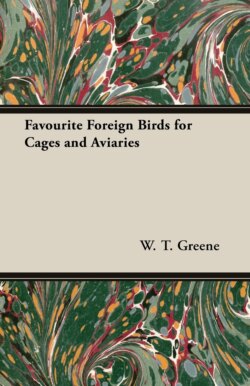Читать книгу Favourite Foreign Birds for Cages and Aviaries - W. T. Greene - Страница 10
На сайте Литреса книга снята с продажи.
ОглавлениеCHAPTER III.
THE CROW FAMILY
(Corvidœ).
The White-backed Piping Crow—The Hunting Crow—The Wandering Pie—The Chinese Blue Pie—The Chinese Blue Magpie—The Spanish Blue Magpie—The Blue-bearded Jay—The Pileated Jay.
THERE are quite a number of most delightful foreign birds belonging to the Crow family, many of which make the most charming pets and should have a place in every collection: the only drawback to keeping them is that, as a rule, they are of a tyrannical disposition, and cannot be kept at close quarters with birds belonging to other families, particularly if smaller than themselves.
They may be generally described as omnivorous in their habits, and in confinement should be fed on meat, fruit, boiled maize or other corn, ants’ eggs, and insects of all kinds; the two latter items for the smaller members of the family, while the larger every now and then will need a mouse or a small bird to keep them in health. I propose taking the latter first, premising that they are all most intelligent birds and susceptible of being completely tamed.
THE WHITE-BACKED PIPING CROW, Gymnorhina leuconota, is an Australian species, and is a general favourite with the Colonists, by whom it is popularly known as the Magpie, not only on account of its susceptibility for domestication, but of the invaluable services it renders to them by the destruction of innumerable hosts of noxious insects, especially scorpions and monstrous centipedes, which are only a shade less venomous than the former repulsive-looking creatures.
This species is stated in the list of the Zoological Society to be a native of South Australia, but this is too restricted a habitat, as it is common in Victoria and New South Wales, and differs but slightly from the Tasmanian Piping Crow, of which the same authority has constituted a distinct species under the name of Gymnorhina organica.
The White-backed Piping Crow is well described by its English name: it is a fine bird about the size of our Carrion Crow, with a strong beak of a bluish colour, white back, and black body.
Some of these birds, especially if reared by hand from the nest, make most accomplished talkers, and will also learn to whistle a tune or tunes, when, as their voice is naturally harmonious and mellow, a very fine effect is produced: the only drawback is that their notes are rather too loud for the house; they are very attractive, however, in the open air.
All the Piping Crows are quite hardy, and will winter readily out of doors in this country; but no instance of their having nested in confinement has ever come to my knowledge, though in a suitable place I see no reason why they should not do so.
In the matter of diet they are very accommodating, and have a special predilection for picking a bone: all is fish that comes to their net, and the aviarist will not have much difficulty in providing for their wants, as they will thrive on any kind of scraps from their owner’s table.
If lodged in a cage, this must be of considerable dimensions and be carefully attended to, for otherwise the Piping Crow, on account of its size and the miscellaneous nature of its diet, would soon render uninhabitable the place where it was kept. In a large outdoor aviary, however, there would not be the same objection, and, everything considered, that is the best position for such a bird, or it may be allowed the free range of a garden if one of its wings is clipped.
The female does not greatly differ in appearance from her mate, but is rather smaller, and the white portions of her plumage are more or less tinged with grey; she can pipe, and will learn to talk and whistle almost as well as the male.
THE HUNTING CROW, Cissa venatoria, is one of the most beautiful members of this group of birds, as well as one of the most interesting: it is a native of India, and is occasionally imported in considerable numbers, but appears to be rather delicate, and does not usually survive its captivity for any length of time.
In size, the Hunting Crow about equals our English Magpie, but has a shorter tail; its strong beak and legs are a bright orange-red; from either side of the mouth a black band, embracing the eye, projects backwards to the middle of the head, which is ornamented with a crest of long, narrow feathers, which the bird has the power of raising up, but which it usually carries lying flat. The whole plumage is of a soft, silky texture—its general colour is sky-blue in some specimens and sea-green in others; the wings are chestnut colour with white spots, and the tail is similarly marked. It is a gorgeous-looking creature, and a great ornament to an aviary.
It is chiefly found in Nepaul and the Himalayas, where it is sufficiently abundant and very frequently domesticated. In confinement it may be fed as a Jackdaw, giving more animal food, especially small birds, which it plucks, feather by feather, before eating. A large cage is necessary on account of the delicacy of its feathers, and it should never be put in a dark place, as light is indispensable for the preservation of its beautiful colours, which quickly fade away and become dull and dingy amid gloomy surroundings.
THE WANDERING PIE, Dendrocitta vagabunda, is another member of this family that is well deserving of the attention of amateurs, but space, will not admit of a detailed description. The same remarks will also apply to the CHINESE BLUE PIE, Urocissa sinensis; THE CHINESE BLUE MAGPIE, Cyanopolius cyanus; THE SPANISH BLUE MAGPIE, Cyanopolius cooki; THE BLUE-BEARDED JAY, Cyanocorax cyanopogon, and THE PILEATED JAY, Cyanocorax pileatus, all of which are handsome and lively birds, and not difficult to preserve in confinement.
